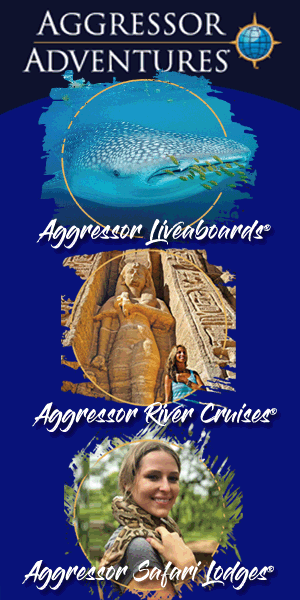Long before we cleared the point, we could hear the cacophony of incessant barking, meaning there was no doubt that we were going to see plenty of animals. As we made the turn we were still several hundred yards away from the anchorage at the rookery, but already we could see dozens of big sausage-shaped creatures belly-flopped on the sandy beach and along the rocks. More animals were in the water with their heads bobbing up and down at the surface while another handful began to race toward our boat in “porpoising” style.
In a voice filled with obvious excitement, one of my shipmates enthusiastically said “nothing better than diving with seals!” Almost simultaneously I heard someone else say “look at all those sea lions!” So what were those animals that I was looking at, seals or sea lions, or are those terms interchangeable, I wondered. Or perhaps, we were looking at two types of animals but I couldn’t see the differences my shipmates noted.
Not knowing what was correct, I asked my friends and thus, started a discussion in which I soon realized that I was not the only confused soul. So take comfort; if you don’t know the difference between seals and sea lions, you certainly are not alone.
To cut to the chase, while seals and sea lions share many abilities, when correctly used the terms represent distinct groups of animals that are significantly different from one another.
Cause for Confusion
Most people are familiar with seals and sea lions, even though they might not be able to distinguish between the two groups. For many, the initial familiarity results from visits to marine theme parks where performing sea lions are the stars of the show.
In most cases, at least in the United States, the stars of these shows are California sea lions (Zalophus californianus) even though many people routinely refer to the performances as “seal shows.” While most species of seals and sea lions inhabit areas north of 30 degrees north latitude and south of 50 degrees south latitude, California sea lions range from the Bering Sea off Alaska to Ecuador’s Galapagos Islands. In fact, many of the more popular dive sites in central and southern California as well as in Mexico’s Sea of Cortez are at well-known areas called rookeries where California sea lions gather during certain times of the year.
Breeding male California sea lions, known as bulls, grow to as large as 800 pounds (360 kg) and 10 feet (3 m). The bulls are huge next to us, but they are not even half the bulk of the less common, but yellow-to-auburn-colored Stellar (aka Steller) sea lions. Bulls attain proportions of 13 feet (4 m) and 2,200 pounds (990 kg).
It should be noted that California sea lions commonly share territory with Stellar sea lions, harbor seals and occasionally with northern elephant seals, Guadalupe fur seals and northern fur seals. As a result, it isn’t safe to assume that if you see an animal that looks like a seal or sea lion along the West Coast of the United States that the animal is a California sea lion.
Harbor seals (Phoca vitulina) are commonly encountered in central and Southern California waters. Their mottled black, white and gray fur makes it easy to distinguish these seals from other seals and sea lions. Unlike California sea lions, Stellar sea lions (Eumetopias jubatus) and northern elephant seals (Mirounga leonina), harbor seals make very little noise. While generally shy, harbor seals sometimes closely follow divers throughout long dives, and on several occasions I have had a harbor seal playfully rest its head on my fins as I was bobbing on the surface.
Although Californians typically refer to northern elephant seals simply as elephant seals, a similar species known as the southern elephant seal (Mirounga angustirostris) inhabits portions of the Southern Hemisphere. The southern elephant seal is the largest of all the seals with bulls attaining proportions of 16 feet (4.8 m) and 5,000 pounds (2,250 kg). Both species are known for the large, bulbous snouts of the males, which along with their size is the origin of their name.
Northern elephant seals are superb deep divers with females routinely going as deep as 4,100 feet (1,242 m). They remain submerged for as long as an hour with as little as three minutes on the surface before making another deep dive to resume their hunt for fishes and squids. Males have yet to be monitored.
The northern fur seal (Callorhinus ursinus) can also be seen in waters along the West Coast of North America. As is the case with many seals, northern fur seals were once hunted for their very fine fur that has more than 300,000 hairs per square inch. Breeding colonies represent the largest gathering of a single species of seal with as many as 1.5 million northern fur seals gathering in places in Alaska’s Pribilof Islands.
Wing-footed Wonders
Surprising to many lay people, evolution specialists maintain that seals are more closely related to cats and bears than they are to sea lions. There are also obvious similarities between seals and sea lions.
Both seals and sea lions are described in the taxonomic order Pinnipedia, a grouping of carnivorous marine mammals that includes 20 genera and 31 species of seals, sea lions, and walruses. As mammals, pinnipeds are warm-blooded, breathe air with lungs, have hair, bear live young, and females nurse their young, providing milk via their mammary glands. The word pinniped is derived from the Latin meaning fin-footed or wing-footed, and refers to the fact that pinnipeds possess two front and two hind flippers. All pinnipeds have elongated, torpedo-shaped bodies that while looking rather bulbous on land prove to be efficiently streamlined when swimming.
Three families of marine mammals are known as pinnipeds. They are:
Phocidae, a grouping that includes 19 species and 10 genera of “true seals,” also known as “hair seals.” Phocids are broadly distributed along coastlines above 30 degrees north latitude and below 50 degrees south latitude with some species occurring in intermediate tropical localities.
Otaridae, a family that consists of 14 species of fur seals and sea lions, most of which live in southern oceans, along the coasts of southern South America, Africa and Australia, as well as New Zealand and islands farther south. Only four species occur north of the equator (all in the Pacific Ocean). Fur seals have longer flippers and thicker fur than sea lions.
Odobenidae, a family of only one, the walrus (Odobenus rosmarus). Inhabiting the Arctic Ocean and adjacent seas, the walrus is one of the larger and more unusual pinnipeds, having been described as “a saber-toothed seal” that usually eats clams but may prey on the young of other seals and even walruses.
Seals, fur seals and seal lions share a number of characteristics. All species possess a thick hide and a heavy layer of fat known as blubber that lies just underneath the skin and is used to protect them from cold and as a reserve of energy. The nostrils of these air-breathing marine mammals consist of two slits that can be closed when they are underwater. Both seals and sea lions also have modified fore and hind limbs known as flippers. These limbs are used to help the animals maneuver both on land and in the water.
Most pinnipeds are carnivores. Their favorite prey varies from fishes and squids to crustaceans and mollusks and in some cases birds and other mammals. The typical sizes of individual species of seals and sea lions varies considerably with full-grown males generally being larger than females of the same species. They are relatively long-lived animals with many enjoying life spans of more than 20 years. Some pinnipeds spend a lot of time on land while others reside primarily in the sea.
Telling Them Apart
Once you become familiar with the characteristics of seals and sea lions, you will be able to easily distinguish between the two groups by noting their external ears, or lack of ears, and by paying attention to the way they use their flippers both on land and in the water. Sea lions have small external ears that are lacking in seals. While these small ears are one factor that distinguishes seals from sea lions, some specialists routinely refer to sea lions as “eared seals.” No doubt this reference can lead to confusion among lay people.
The four legs of ancestral pinnipeds have been modified into flippers, an ideal tool for animals whose survival depends on their ability to move from place to place, capture prey and escape predation in the water. However, the design of the flippers is different in seals and sea lions. The fore flippers of sea lions are comparatively large and are used as their chief means of propulsion in the water. Sea lions use their rear flippers as a rudder. In contrast, seals gain their thrust and propel themselves with their hind flippers. Seals are not capable of turning their hind flippers forward, and as a result seals are less mobile than sea lions when on land.
One more major difference between the two groups is that sea lions possess a rather harsh coat while seals have a dense soft undercoat of hairs that is protected by coarse guard hairs. Providing warmth against the elements, the fine hairs are short and slick. The coarse hairs serve as protectors for the fine hairs, helping to reduce wear and tear.
A factor that complicates the issue of identification, especially when one is new to the world of pinnipeds, is that it is not uncommon to discover various species of seals and sea lions intermingling both on land and in the water. Both seals and sea lions are highly gregarious animals that routinely gather in large herds or colonies during many times of the year. Pups of both sexes and females without pups tend to be far more social than breeding males and females with pups. Point Bennett on San Miguel Island, the northern and westernmost of Southern California’s eight Channel Islands, is sometimes simultaneously inhabited by as many as 10,000 seals and sea lions of as many as seven different species. This is the largest known gathering of different species of seals and sea lions anywhere in the world.
Diving With Pinnipeds
Diving at a pinniped rookery area when pups and yearlings are at play is about as entertaining as diving gets. Adults of both sexes often seem to have lost their zest for play, but the younger animals more than make up for any lack of enthusiasm in the adults. The goings-on at a rookery remind me of recess at an elementary school where controlled chaos seems to be the order of the day. The youngsters often dart right at you full speed ahead only to veer away at the last possible instant.
The playful nature and endearing faces of pups and sub-adults of both sexes cause us to fall head over heels in love with pinnipeds. However, it is all too easy to also believe that they have fallen in love with us. While magical memories often result when diving with pups and sub-adults of both sexes, bulls (adult males) should not be taken for granted.
The primary role of bulls is to reproduce and, depending upon the species, to maintain dominance over territory or harems of females. They take this job very seriously and intruders, including divers, are not welcomed. So, if you see a bull blowing bubbles, bearing teeth or barking at you, “give ground immediately” is the best course of action.





